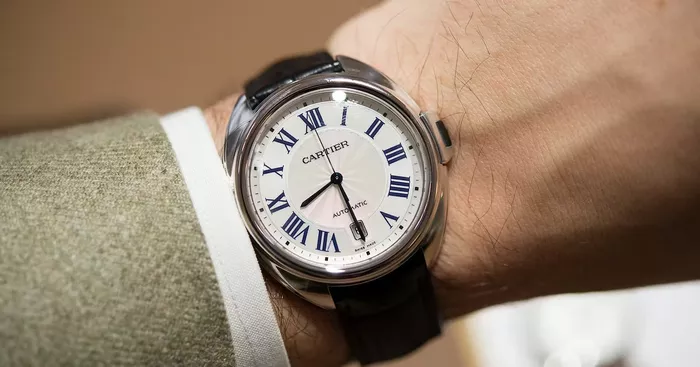I. Unlocking Elegance: Introduction to the Clé de Cartier
The Clé de Cartier, introduced in 2015, stands as a testament to Cartier’s commitment to innovation and design, combining horological excellence with aesthetic brilliance. The name “Clé,” derived from the French word for “key,” perfectly encapsulates the watch’s unique feature – a crown that takes inspiration from a traditional winding key. This section will delve deeper into the historical context of the Clé de Cartier, exploring how its design narrative aligns with Cartier’s rich heritage. By understanding the origins of this timepiece, one can better appreciate the blend of tradition and modernity that defines the Clé de Cartier.
II. A Captivating Design: The Clé de Cartier Aesthetic
The design of the Clé de Cartier is a celebration of curves and straight lines, a harmonious symphony that encapsulates Cartier’s signature style. The standout feature, the key-shaped crown, serves as both a functional element and a distinctive design choice. The case, meticulously crafted in various materials, embodies a perfect equilibrium between boldness and subtlety. The dial, a canvas of minimalistic sophistication, showcases Cartier’s iconic Roman numerals and a carefully placed date window. The section will further explore the intricate details of the design, emphasizing how each element contributes to the overall aesthetic appeal.
The bracelet of the Clé de Cartier is not merely a utilitarian strap but an artful extension of the watch’s design philosophy. Whether crafted in leather or metal, the bracelet seamlessly integrates with the case, emphasizing both comfort and visual coherence. The deployment buckle, adorned with the Cartier logo, exemplifies the brand’s attention to detail. The watch’s overall profile, with its domed sapphire crystal, further enhances its visual allure. By exploring the finer points of the design, one can grasp the thoughtful craftsmanship that goes into ensuring the Clé de Cartier is not just a timepiece but a wearable work of art.
III. Innovative Crown: The Key to Cartier’s Distinction
The most distinctive feature of the Clé de Cartier is undeniably its innovative crown, designed in the shape of a key. While visually striking, this key-shaped crown is more than a whimsical design choice. It represents a feat of engineering brilliance, allowing for an unconventional yet highly intuitive method of winding and setting the time. Delving into the design and functionality of this crown, this section will illustrate how Cartier’s commitment to innovation extends to the very heart of the watch. Understanding the ergonomic design ensures a seamless interaction with the watch, underlining Cartier’s dedication to enhancing the user experience.
IV. Precision in Motion: The Clé de Cartier Movement
At the core of the Clé de Cartier lies a mechanical movement, a testament to Cartier’s unwavering dedication to horological excellence. Whether powered by an automatic or manual-winding movement, the Clé de Cartier guarantees precise timekeeping. This section will go beyond the surface to explore the inner workings of the movement, shedding light on the meticulous craftsmanship and technical prowess that define Cartier’s watchmaking. From the oscillating weight of the automatic movement to the intricate details of the manual-winding mechanism, each aspect showcases Cartier’s commitment to precision and reliability in the realm of haute horlogerie.
V. A Variety of Models: Exploring the Clé de Cartier Collection
The Clé de Cartier collection unfolds as a diverse array of models, catering to a spectrum of tastes and preferences. From the classic stainless steel iteration to more opulent versions featuring diamonds and precious metals, Cartier ensures that the collection embodies diversity without compromising the core design elements of the Clé de Cartier. By offering an overview of the available models, this section guides readers through the nuances of each variant. Whether one gravitates towards the understated elegance of a simpler model or the extravagant luxury of a diamond-set version, Cartier ensures the Clé de Cartier collection caters to a wide audience.
VI. Beyond Timekeeping: The Clé de Cartier as a Lifestyle
The Clé de Cartier transcends its role as a timekeeping instrument; it transforms into a statement piece that seamlessly complements a lifestyle of sophistication. This section explores how the watch effortlessly transitions between formal and casual settings, becoming a versatile accessory for diverse occasions. Whether it graces the wrist at a black-tie event or subtly enhances everyday attire, the Clé de Cartier becomes an integral part of the wearer’s style. The water-resistant feature of the watch adds a practical dimension to its versatility, making it suitable for various activities. By understanding the lifestyle aspects, one can appreciate how the Clé de Cartier becomes more than a watch – it becomes a companion that enhances life’s myriad moments.
VII. Frequently Asked Questions
1. What does “Clé de Cartier” mean?
“Clé de Cartier” translates to “Cartier key” in French. The name symbolizes the key-shaped crown of the watch, reflecting its innovative and functional design.
2. Why is the crown of the Clé de Cartier designed like a key?
The key-shaped crown is a homage to traditional winding keys used in pocket watches. It serves a functional purpose while adding a unique and innovative design element to the watch.
3. What materials are available for the Clé de Cartier?
The Clé de Cartier is available in various materials, including stainless steel, gold, and combinations of precious metals. The diverse material options cater to different preferences and styles.
4. How often does the Clé de Cartier need to be wound or serviced?
For automatic models, regular wearing keeps the watch wound. Manual-winding models may require winding every 1-2 days. Cartier recommends servicing the watch every 3-5 years to maintain optimal performance.
5. Is the Clé de Cartier suitable for water-related activities?
While water-resistant, the Clé de Cartier is not designed for extensive water exposure. It can withstand splashes and brief immersion but should not be worn during activities such as swimming or diving.


